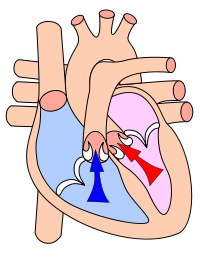
Photo from wikipedia
Currently, medical image domain translation operations show a high demand from researchers and clinicians. Amongst other capabilities, this task allows the generation of new medical images with sufficiently high image… Click to show full abstract
Currently, medical image domain translation operations show a high demand from researchers and clinicians. Amongst other capabilities, this task allows the generation of new medical images with sufficiently high image quality, making them clinically relevant. Deep Learning (DL) architectures, most specifically deep generative models, are widely used to generate and translate images from one domain to another. The proposed framework relies on an adversarial Denoising Diffusion Model (DDM) to synthesize echocardiography images and perform domain translation. Contrary to Generative Adversarial Networks (GANs), DDMs are able to generate high quality image samples with a large diversity. If a DDM is combined with a GAN, this ability to generate new data is completed at an even faster sampling time. In this work we trained an adversarial DDM combined with a GAN to learn the reverse denoising process, relying on a guide image, making sure relevant anatomical structures of each echocardiography image were kept and represented on the generated image samples. For several domain translation operations, the results verified that such generative model was able to synthesize high quality image samples: MSE: 11.50 ± 3.69, PSNR (dB): 30.48 ± 0.09, SSIM: 0.47 ± 0.03. The proposed method showed high generalization ability, introducing a framework to create echocardiography images suitable to be used for clinical research purposes.
Journal Title: IEEE Access
Year Published: 2023
Link to full text (if available)
Share on Social Media: Sign Up to like & get
recommendations!